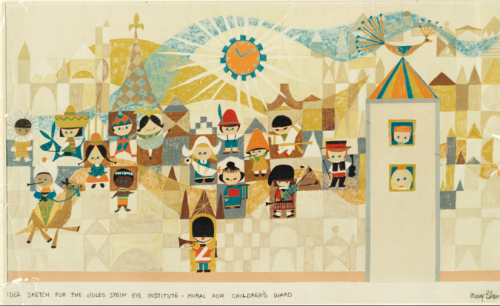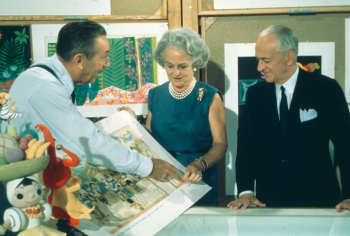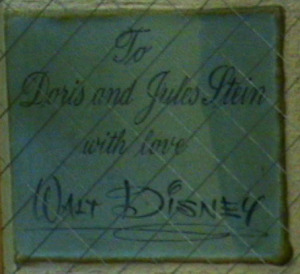This month we celebrate the Season of Giving, and the generous legacy of Walt Disney. In addition to the films and entertainment that Walt gave us, and the bounty of Walt’s influence in many areas of our culture around the world, Walt generously supported charities that meant a great deal to him, including Toys for Tots, The John Tracy Clinic, and the ophthalmic and philanthropic efforts of his longtime friend, Dr. Jules Stein.

Music and medicine, at first glance, are not the most obvious symbiotic relationship. But in the life of Jules Stein this pairing would result in a vital connection. Early on, Stein set his sights on becoming a doctor, and chose the field of ophthalmology as his specialty. He financed his education by playing his violin and saxophone, and continued playing even after he was issued his diploma. As a musician in 1920s Chicago, getting a gig meant you would be at the same venue for the season. Stein decided to take a different approach, and began to represent acts for one-night performances instead. His roster of talent grew quickly, and within a few years he was so successful that he started his own booking agency, Music Corporation of America. Soon after, Stein quit medicine and dedicated himself full time to MCA. His efforts were quick to produce results, and in less than a decade MCA would come to represent all the big names of music and film. Stein would continue expanding and diversifying his business into the dawn of television. Television not only gave Stein another entertainment field to conquer, but would also lead him down the path that ended at Walt Disney’s doorstep.
 In the early fifties, Walt had decided to embark on building Disneyland, knowing it would be a costly project. Television was in its infancy, but Walt knew it would be the key to unlocking the doors to his dream theme park. “Every time I got to thinking of television, I would think of this park. Instead of considering TV a rival, when I saw it I said, ‘I can use that…here’s the way I’ll get my park going.”
In the early fifties, Walt had decided to embark on building Disneyland, knowing it would be a costly project. Television was in its infancy, but Walt knew it would be the key to unlocking the doors to his dream theme park. “Every time I got to thinking of television, I would think of this park. Instead of considering TV a rival, when I saw it I said, ‘I can use that…here’s the way I’ll get my park going.”
Jules Stein, after courting Roy and Walt for years, helped navigate the newly built streets of television by helping Walt get the deal with ABC to air Disneyland. It was the beginning of a lifelong business partnership that evolved into an unbreakable friendship.
Stein would often ask Walt’s opinion on business matters. When Stein’s MCA acquired Universal Studios in 1958 he invited Walt on a tour of the lot. The purpose was simple: he needed to know if Walt thought the studio tours of the 1920s could be revived. Walt’s short answer was “yes.” Walt also became a loyal supporter of Stein’s philanthropic efforts.
Stein never completely abandoned his medical roots, and would continue to support eye research. After a visit with his wife Doris to New York Lighthouse for the Blind, she encouraged him to use his knowledge and influence to help the blind. He founded RPB, Research to Prevent Blindness, Inc. in 1960. Together, they knew that more had to be done, and moved forward to build a world-renowned institute that would be dedicated to the treatment and prevention of blindness.
 Established in 1966, the Jules Stein Eye Institute represents the culmination of that dream, creating a world-renowned center dedicated to the preservation of vision and the prevention of blindness. The Institute’s comprehensive programs for the care of patients with eye disorders, research in the vision sciences, education in the field of ophthalmology and outreach to the community, coupled with its state-of-the art facilities, have brought national and international recognition to the Institute and UCLA. Many have contributed to this tradition of excellence, and many more will carry it forward as the Institute continues its mission to advance ophthalmology worldwide.
Established in 1966, the Jules Stein Eye Institute represents the culmination of that dream, creating a world-renowned center dedicated to the preservation of vision and the prevention of blindness. The Institute’s comprehensive programs for the care of patients with eye disorders, research in the vision sciences, education in the field of ophthalmology and outreach to the community, coupled with its state-of-the art facilities, have brought national and international recognition to the Institute and UCLA. Many have contributed to this tradition of excellence, and many more will carry it forward as the Institute continues its mission to advance ophthalmology worldwide.
Walt decided that a simple monetary contribution would not be either a sufficient gift, or a reflection of his personal feelings for the Steins. Instead, Walt commissioned Mary Blair to create a one-of-a-kind ceramic mural for the walls of the Pediatric Waiting Room of the new institute.
And so, when the Jules Stein Eye Institute opened in 1966, the life and career of Stein had come full circle.
Fun Fact: After Ellis Island was decommissioned as an immigration station in the mid-1950s, Jules Stein suggested that Walt buy the historic 27.5 acre island—and build another Disneyland there!
The story of the Jules Stein Eye Institute ceramic tile mural, along with the actaul test tile set pictured above, can now be seen in the Lower Level of The Walt Disney Family Museum, along with other artifacts and remembrances of "Our Lady of Flair," Mary Blair.
Images above: 1) Mary Blair's rendering of the tile mural design for Jules Stein Eye Institute. Courtesy of the Walt Disney Family Foundation. 2) Walt Disney at WED model shop with Jules and Doris Stein, at mural presentation for Jules Stein Eye Institute. © Disney 3) Tile sample created to test glazes and quality of the basic tile for the mural at Jules Stein Eye Institute. Courtesy of the Walt Disney Family Foundation.

Anel Muller
Registrar/Curatorial Assistant
